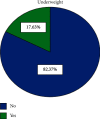Prevalence of Underweight and Its Associated Factors among Reproductive Age Group Women in Ethiopia: Analysis of the 2016 Ethiopian Demographic and Health Survey Data
- PMID: 32802085
- PMCID: PMC7403906
- DOI: 10.1155/2020/9718714
Prevalence of Underweight and Its Associated Factors among Reproductive Age Group Women in Ethiopia: Analysis of the 2016 Ethiopian Demographic and Health Survey Data
Abstract
Background: Underweight is defined as being below the healthy weight range. Underweight in reproductive age group women not only affects women but also increases the risk of an intergenerational cycle of malnutrition and child mortality. Various factors are linked with underweight among women. However, studies on the prevalence of underweight and its associated factors among women are limited in Ethiopia. Hence, this study aimed to assess the prevalence of underweight and its associated factors among reproductive age group women in Ethiopia.
Methods: For this study, data were drawn from the 2016 Ethiopian demographic and health survey (EDHS). From the total, 15,683 women participants of the 2016 EDHS; a subsample of 2,848 participants aged 15-49 years who had a complete response to all variables of interest were selected and utilized for analysis. Data were analyzed using SPSS version 20 software program. Pearson's chi-squared test was used to assess the frequency distribution of underweight and is presented with different sociodemographic characteristics. Logistic regression models were applied for analysis. A two-sided p value of less than 0.05 was used to declare a statistically significant association between the independent variables and underweight among women.
Results: The prevalence of underweight among reproductive age group women in Ethiopia was 17.6%. The majority, 78.3% of underweight women, were rural dwellers. The odds of being underweight was higher among the young aged women, among those residing in rural areas, in those with higher educational status, and in those who have one or more children. On the other hand, the odds of underweight among respondents living in Benishangul, SNNPR, and Addis Ababa were less compared to those living in Dire Dawa. Similarly, the odds of underweight among participants with a higher level of husband or partner educational status and among those who chew Khat were less compared to their counterparts.
Conclusion: Underweight among reproductive age group women in Ethiopia is still a major public health problem, particularly among rural dwellers. Underweight was significantly associated with different sociodemographic variables. Hence, context-based awareness creation programs need to be designed on the prevention methods of underweight in Ethiopia, giving especial emphasis to those residing in rural areas.
Copyright © 2020 Ayelign Mengesha Kassie et al.
Conflict of interest statement
The authors declare that they have no conflicts of interest regarding the publication of this paper.
Figures
Similar articles
-
Current khat (Catha edulis F.) use among Ethiopian women and its association with anemia and underweight: A cross-sectional analysis from Ethiopian Demographic and Health Survey.PLoS One. 2024 May 31;19(5):e0297831. doi: 10.1371/journal.pone.0297831. eCollection 2024. PLoS One. 2024. PMID: 38820499 Free PMC article.
-
Education and prevalence of overweight and obesity among reproductive age group women in Ethiopia: analysis of the 2016 Ethiopian demographic and health survey data.BMC Public Health. 2020 Jul 31;20(1):1189. doi: 10.1186/s12889-020-08941-w. BMC Public Health. 2020. PMID: 32736617 Free PMC article.
-
Nutritional paradox in Ethiopian women: Multilevel multinomial analysis.Clin Nutr ESPEN. 2020 Apr;36:60-68. doi: 10.1016/j.clnesp.2020.02.005. Epub 2020 Feb 28. Clin Nutr ESPEN. 2020. PMID: 32220370
-
Factors associated with chronic energy malnutrition among reproductive-age women in Ethiopia: An analysis of the 2016 Ethiopia demographic and health survey data.PLoS One. 2020 Dec 11;15(12):e0243148. doi: 10.1371/journal.pone.0243148. eCollection 2020. PLoS One. 2020. PMID: 33306693 Free PMC article.
-
High burden of undernutrition among primary school-aged children and its determinant factors in Ethiopia; a systematic review and meta-analysis.Ital J Pediatr. 2020 Aug 26;46(1):118. doi: 10.1186/s13052-020-00881-w. Ital J Pediatr. 2020. PMID: 32847566 Free PMC article.
Cited by
-
Khat consumption and undernutrition among adult population in Ethiopia: A systematic review and meta-analysis.PLoS One. 2024 Apr 23;19(4):e0299538. doi: 10.1371/journal.pone.0299538. eCollection 2024. PLoS One. 2024. PMID: 38652725 Free PMC article.
-
Association Between Nutritional Status and Physical Activity Among Reproductive Age Women in Arba Minch Health and Demographic Surveillance Site, Southern Ethiopia.Int J Public Health. 2025 Mar 26;70:1608161. doi: 10.3389/ijph.2025.1608161. eCollection 2025. Int J Public Health. 2025. PMID: 40206456 Free PMC article.
-
Current khat (Catha edulis F.) use among Ethiopian women and its association with anemia and underweight: A cross-sectional analysis from Ethiopian Demographic and Health Survey.PLoS One. 2024 May 31;19(5):e0297831. doi: 10.1371/journal.pone.0297831. eCollection 2024. PLoS One. 2024. PMID: 38820499 Free PMC article.
-
Health Behaviors of Austrian Secondary School Teachers and Principals at a Glance: First Results of the From Science 2 School Study Focusing on Sports Linked to Mixed, Vegetarian, and Vegan Diets.Nutrients. 2022 Mar 3;14(5):1065. doi: 10.3390/nu14051065. Nutrients. 2022. PMID: 35268041 Free PMC article.
-
Socioeconomic Inequalities in Women's Undernutrition: Evidence from Nationally Representative Cross-Sectional Bangladesh Demographic and Health Survey 2017-2018.Int J Environ Res Public Health. 2022 Apr 13;19(8):4698. doi: 10.3390/ijerph19084698. Int J Environ Res Public Health. 2022. PMID: 35457563 Free PMC article.
References
-
- Fanzo J., Hawkes C., Udomkesmalee E., et al. Global Nutrition Report: Shining a Light to Spur Action on Nutrition. Geneva, Switzerland: WHO; 2018.
-
- ICF International. Ethiopia Demographic and Health Survey 2011. Calverton, MD, USA: ICF International; 2012.
-
- World Health Organization. Malnutrition. Geneva, Switzerland: World Health Organization; 2020. https://www.who.int/news-room/fact-sheets/detail/malnutrition.
MeSH terms
LinkOut - more resources
Full Text Sources


